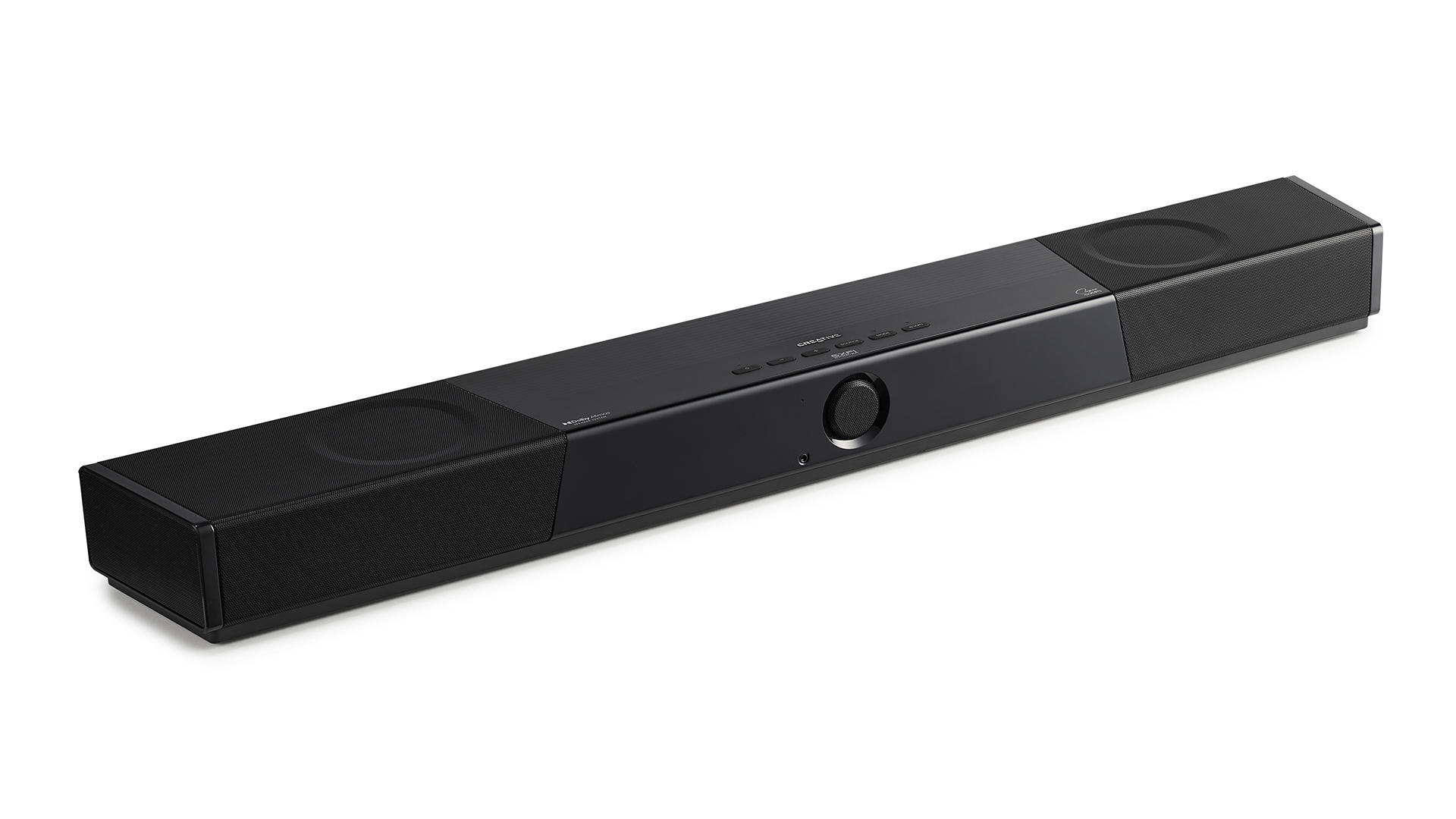What Hi-Fi? Verdict
While not as refined as some, the Creative SXFI Carrier is an engaging all-round performer that really shines with gaming content
Pros
- +
Vibrant sound, particularly for games
- +
HDMI 2.1 passthrough
- +
Fairly compact bar
Cons
- -
Slightly unsophisticated sound
- -
Not the prettiest soundbar
- -
High price for no wi-fi connectivity
Why you can trust What Hi-Fi?
In the 1959 musical Gypsy, Stephen Sondheim summed up the predicament of how to best stand out in a crowded marketplace with his ode to burlesque You Gotta Get A Gimmick. The song is belted out by three veteran strippers respectively embracing the novelty of Roman bugle, interpretive dance and strategically placed lightbulbs to impress their patrons.
Putting its own spin on Sondheim's seasoned advice, the Creative SXFI Carrier Dolby Atmos soundbar offers a particularly idiosyncratic feature to tempt potential users – audio processing that simulates 3D surround sound not through the soundbar’s speakers, but via a pair of headphones to the Carrier soundbar via a mini-jack on the front. In this mode, the company's proprietary SXFI spatial audio is being 'carried' to your ears by the soundbar.
Unusual? Yes. Unnecessary? Maybe. But virtual headphone surround sound is not a wholly surprising feature for Creative to push alongside its flagship soundbar; after all, the company is most well known for its gaming accessories, particularly headsets, many of which tout its SXFI technology for immersive gameplay.
The crucial thing to note here is that while this SXFI headphones processing is a major talking point, it's not actually crucial to the Carrier's success, because it's a good soundbar in its own right.
Build and price
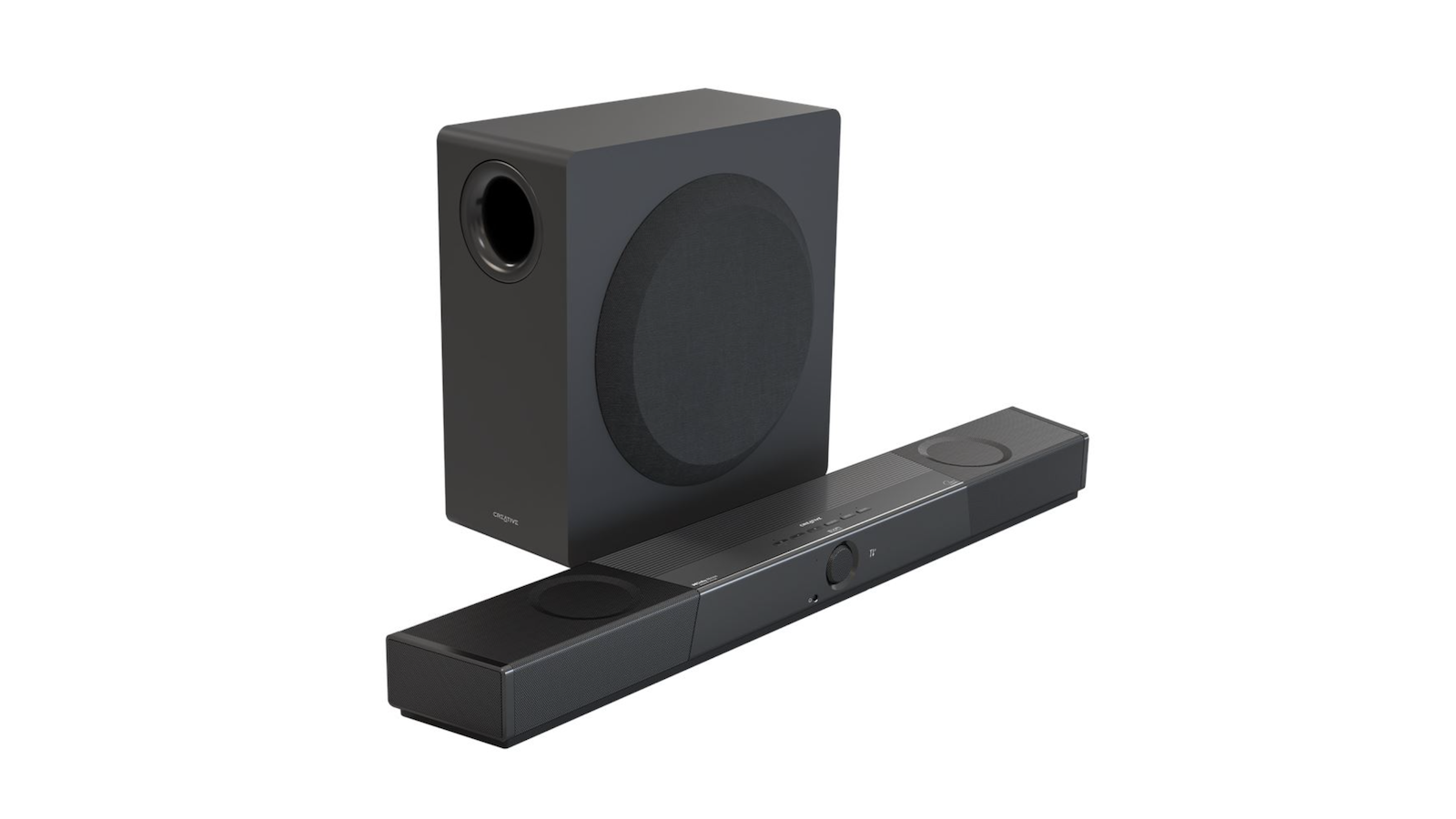
It’s immediately apparent that the Creative SXFI Carrier is a gamer-centric product with its angular build and distinctive mix of matte and gloss black plastic with grille cutouts and recesses that have the slight appearance of cup holders. It's not quite as polished looking as we might expect for a product costing £899 / $1000 (around AU$1396), but it is surprisingly compact for a Dolby Atmos soundbar and, at 88cm wide, could conceivably sit on a desktop as well as in your living room.
Size-wise this is quite a departure from its predecessor, 2018’s mammoth Creative X-Fi Sonic Carrier, which accommodated an extravagant 15 drivers in an 11.2.4 configuration. At 152cm wide, the main soundbar was nearly twice the size of the newer model and priced at $3999 (around £3246, AU$5670) was a fair bit more expensive too.
Features
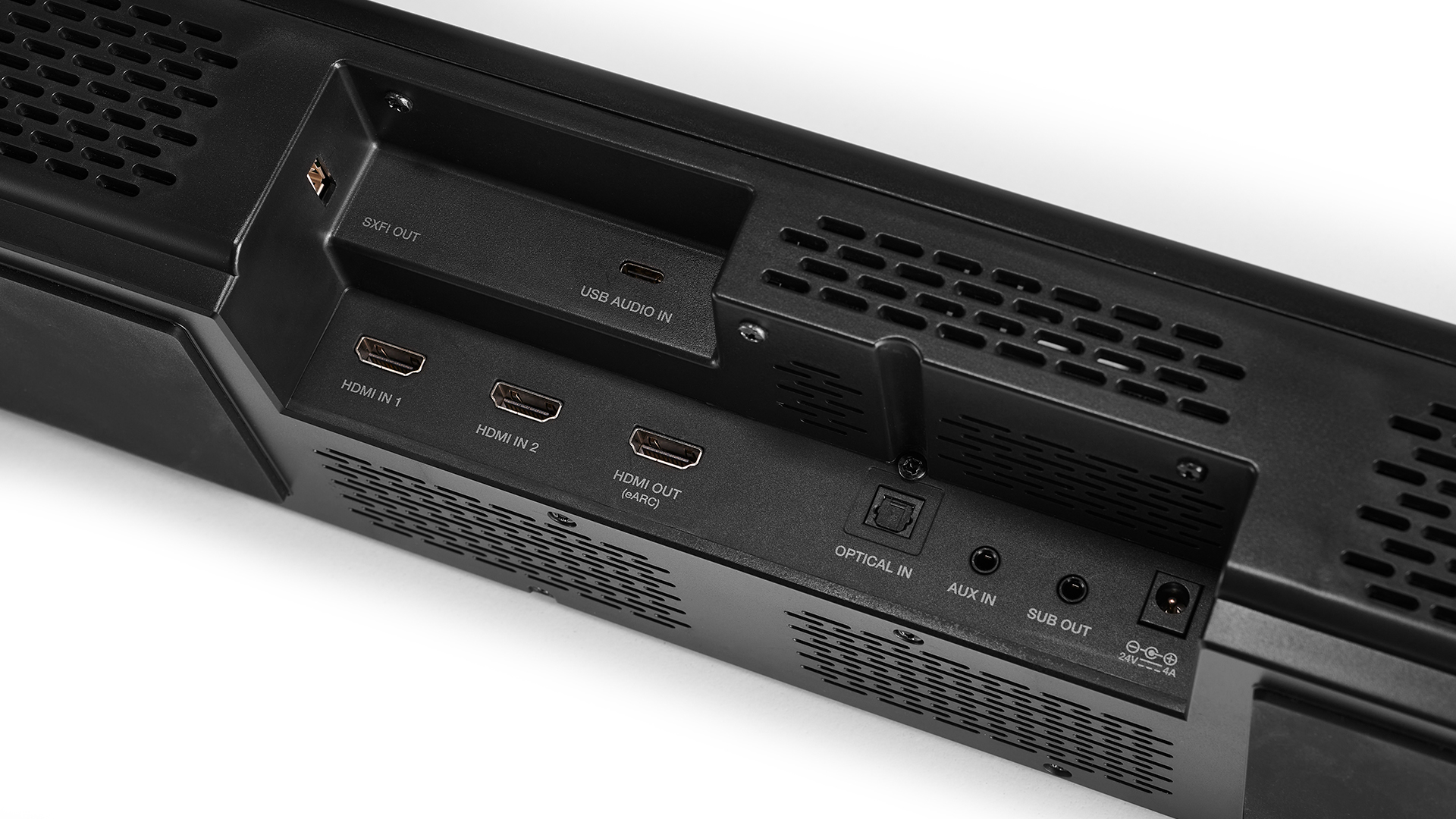
The Creative SXFI Carrier’s console compatibility extends to its impressive connectivity. As well as eARC, there are two further HDMI 2.1 ports capable of passing through 4K@120Hz or 8K@30Hz (in 4:2:0 colour format) as well as HDR with Dolby Vision, HDR10 and HDR10+, and support for performance-enhancing gaming features including ALLM and VRR.
There’s also a USB audio output specifically intended for an SXFI Bluetooth transmitter to connect a compatible pair of Creative's own low latency wireless headphones, and with our test sample, a pair of SXFI Theater headphones were included as part of the purchase price. We have previously tested this model at a standalone price of £190 / $140 (around AU$332). It's worth noting, though, that while the soundbar and headphones combo is available as a bundle from Creative’s UK website it may not be in other territories.
The soundbar can also receive audio wirelessly through Bluetooth 5.0 but disappointingly doesn't include wi-fi connectivity. You could always inexpensively add casting functionality by using a streaming stick in one of the HDMI ports, but it's a fairly glaring omission at this price point.
The lack of wi-fi also means that app control is via Bluetooth, which adds an extra layer of clunkiness to a set-up process that’s not the most user-friendly we’ve come across. Despite having physical playback and source controls (and even one to engage SXFI processing for headphones), there’s no dedicated Bluetooth pairing button on the soundbar or its included remote. Instead, when trying to sync your phone to the soundbar for the first time, the power button does double duty, resulting in several frustrating accidental power cycles.
Connecting the wireless subwoofer over Bluetooth is much more straightforward, and our test sample syncs up immediately, maintaining a stable link for the duration. Users concerned about latency can use a wired mini-jack connection if they wish, although a cable is not included.

Connections 1 x eARC, 2 x HDMI 2.1,1 x optical, USB-C audio in, USB-A SXFI-out, 3.5mm audio out
Sound formats Dolby Atmos, Stereo PCM, Dolby surround, Dolby True HD, Dolby Digital Plus
Bluetooth 5? Yes
Wi-fi? No
Dimensions (hwd) Soundbar 7.6 x 88 x 12.8cm; subwoofer 43 x 22.5 x 45 cm
Weight Soundbar 3.6 kg; subwoofer 12.8kg
Meanwhile, the main soundbar comprises seven drivers in a 5.1.2 configuration with three front-facing tweeters, one of which gets its own individual grille in the centre, making it look a little like a mislaid volume knob. On the top are a pair of steeply raked woofers that disperse sound upwards and forwards, and at the extreme ends sit two side-firing racetrack-style mid-woofers. Each driver has its DSP-controlled amplifier, with a total RMS power of 450W, including the sub.
The Creative Carrier can handle audio up to 24-bit/192kHz and not only supports Dolby Atmos in its lossless True HD format but was in fact developed in association with Dolby itself. It's been dubbed the first ‘Dolby Atmos Speaker System’ soundbar (or DASS).
Dolby’s involvement is probably why there’s no support for rival immersive format DTS:X on board and has resulted in the development of up-mixing technology that uses all drivers at all times regardless of the format being decoded. Other soundbars, including the Bose Smart Soundbar 900, have attempted similar ‘always active’ upmixing (not always successfully, we might add), but the Creative Carrier uniquely takes advantage of the size of its upward drivers by sharply angling them within a perpendicular grille to project sound both forwards for direct audio such as dialogue and upwards to reflect height effects off the ceiling.
Sound
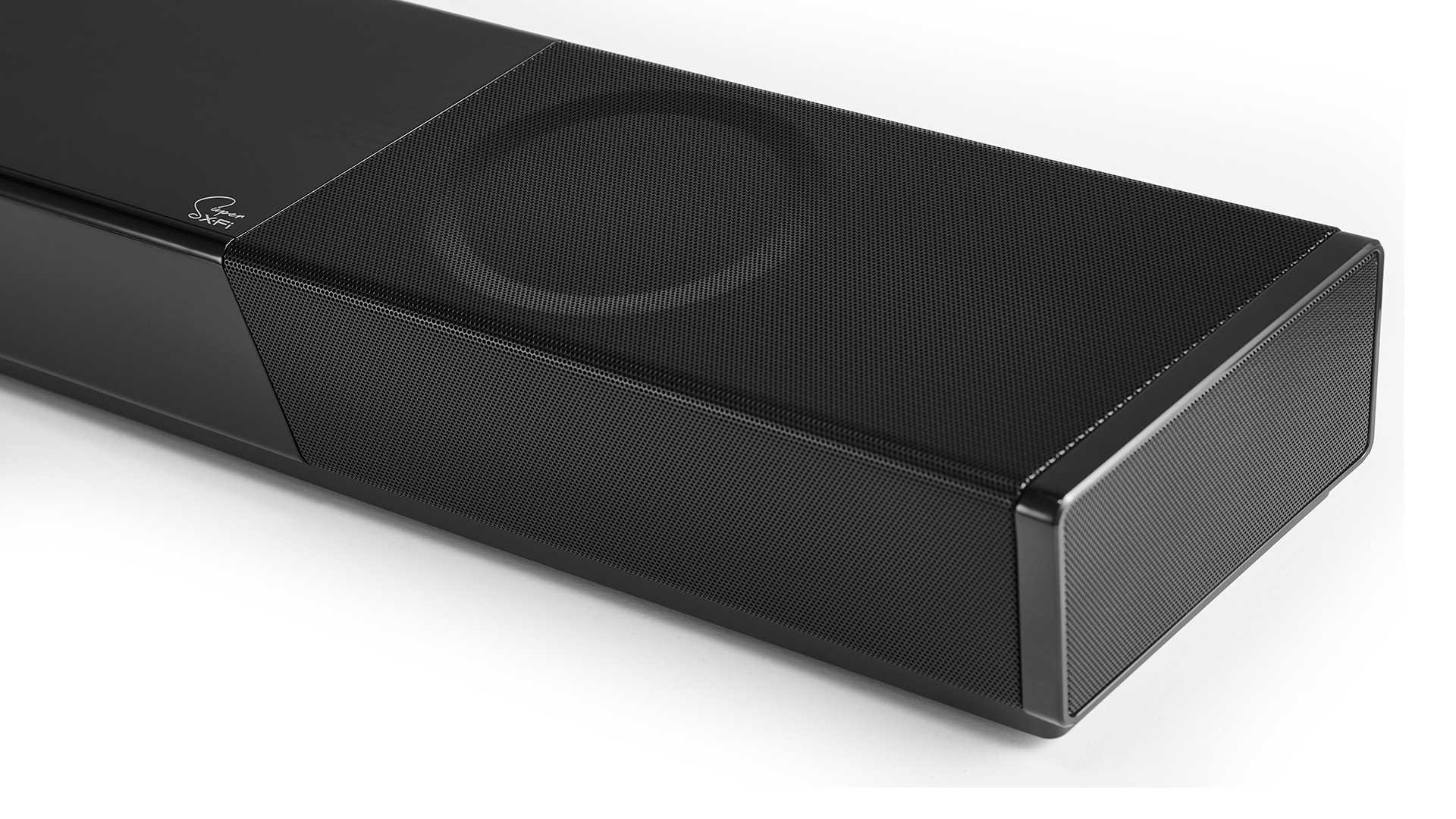
It’s an interesting approach to the conundrum of how to deliver full-range sound from the stunted constraints of a soundbar and results in a fairly distinctive sonic signature that performs well across a variety of content but ultimately comes into its own with gaming.
We stick to Neutral mode for all our testing, finding that Movie, Music and Super Wide all have a negative impact on dynamic range or add unwelcome tonal colour. Despite Creative’s app offering a rudimentary calibration feature based upon manually measuring the distance to your listening position, we turn the level of the Sub down a few notches to lessen its domineering influence. We also tweak up the level of the height drivers slightly, though this should be done with caution as it can cause the midrange to overpower the tweeters.
Watching Unbroken on Blu-ray, the Creative SXFI Carrier has notable width and does a decent job of producing some sense of height and movement as the bomber flies overhead in the opening sequence. With its considerable low-end extension, the sub delivers plenty of dramatic rumble, underscoring the impact of every bomb drop. The bass is relatively agile and more powerful than those we’ve heard from other bundled soundbar packages, too. This lends plenty of scale and weight to the soundtrack, though sometimes higher frequencies can seem subdued in comparison.
The challenging voices from the cockpit are present and clear without resorting to harshness, but there isn’t quite the same feeling of emotive warmth or treble sparkle as you get with the Sonos Arc. Indeed, watching the same sequence on the Sonos, there’s a more cohesive and cinematic overall soundstage, with better integration across the frequency spectrum.
With gaming content, however, it's the Creative SXFI Carrier that shines. And the lively Dolby Atmos soundtrack of Forza Horizon 5 is engaging and dynamic on the punchy if slightly angular-sounding Carrier. Here the spaciousness of the Arc and its lack of a dedicated sub lessens its immediacy in comparison, making it less entertaining than its rival.
We try both the Creative Theatre SXFI headphones and a pair of Sennheiser HD25 to test out the soundbar's signature feature and unfortunately find the surround processing rather synthetic, particularly with voices, even when we make a personalised sound profile using the Super-XFI app, which requires ear and head photos. Thankfully the feature can be disabled, and it is nice to quickly swap between soundbar and headphones, though it could be more useful if there were the option to output sound from both simultaneously.
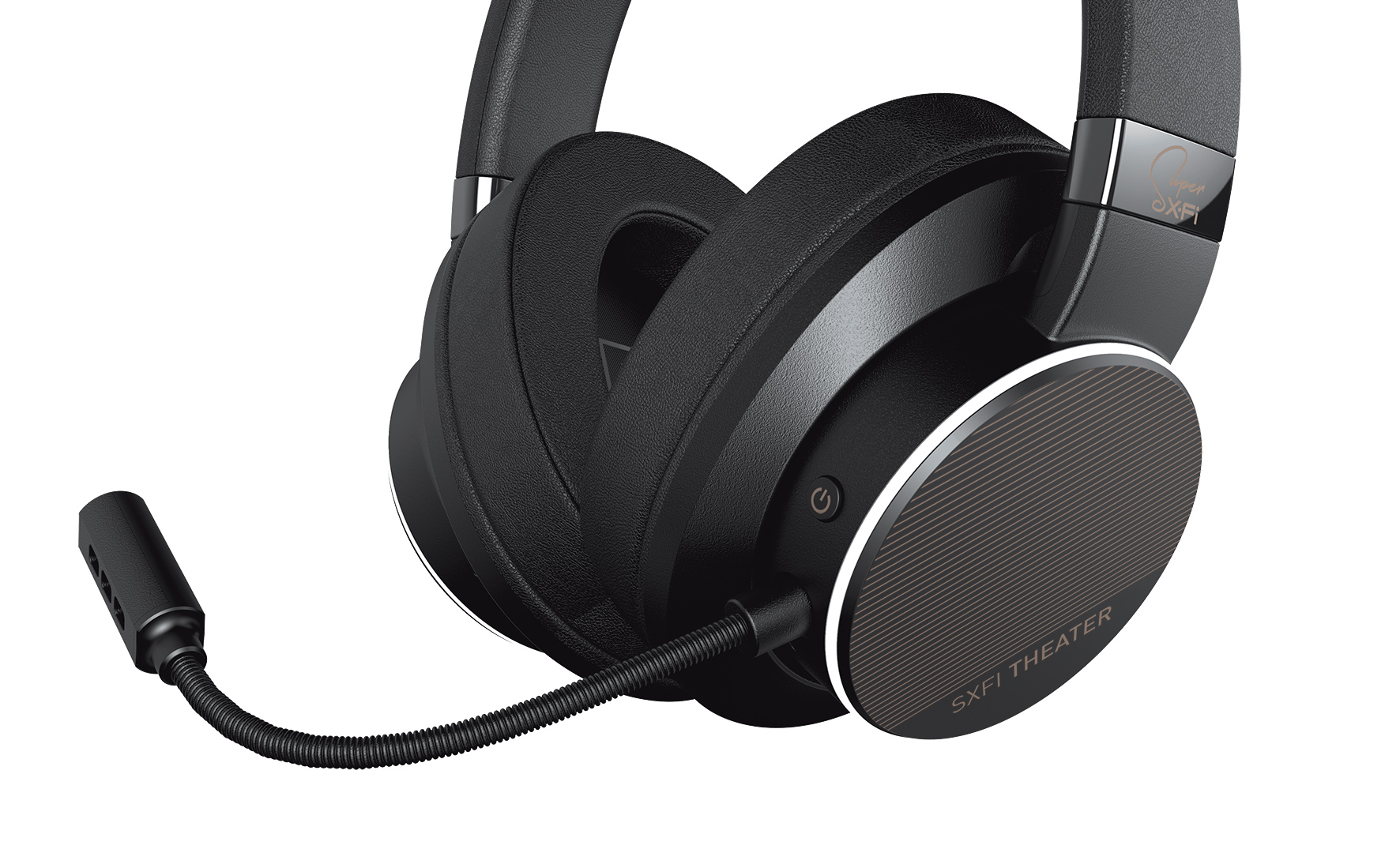
Playing back music, a particular quirk of the Creative Carrier makes itself very evident. There’s consistently a tiny gap before content from media apps on our connected Samsung TV is output, meaning that we always miss the first note of any track. Once things get going, however, the Carrier proves itself to be a decent musical performer by soundbar standards.
Paul Buchanan’s reflective Mid Air streamed via the connected TV’s Tidal app is surprisingly detailed in higher frequencies, highlighting subtle touches such as the slow shimmer of strings and barely-there organ that build through the second verse or the closing cymbal brush and final faulting exhale. The emotive vocal has more of a sense of proximity presence than with the Sonos Arc, which, while more fluid and coherent overall, sanitises some of Buchanan’s huskiness.
Switching to the electro-bucolic Summertime Clothes by Animal Collective, the upmixing of the Creative SXFI Carrier holds together remarkably well as growing layers of tripping cross-rhythms weave across one another. On other soundbars, this track can lack a sense of musicality and expression, but here there’s nice tonal separation with the sub bringing out a welcome depth to the lower mids.
Verdict
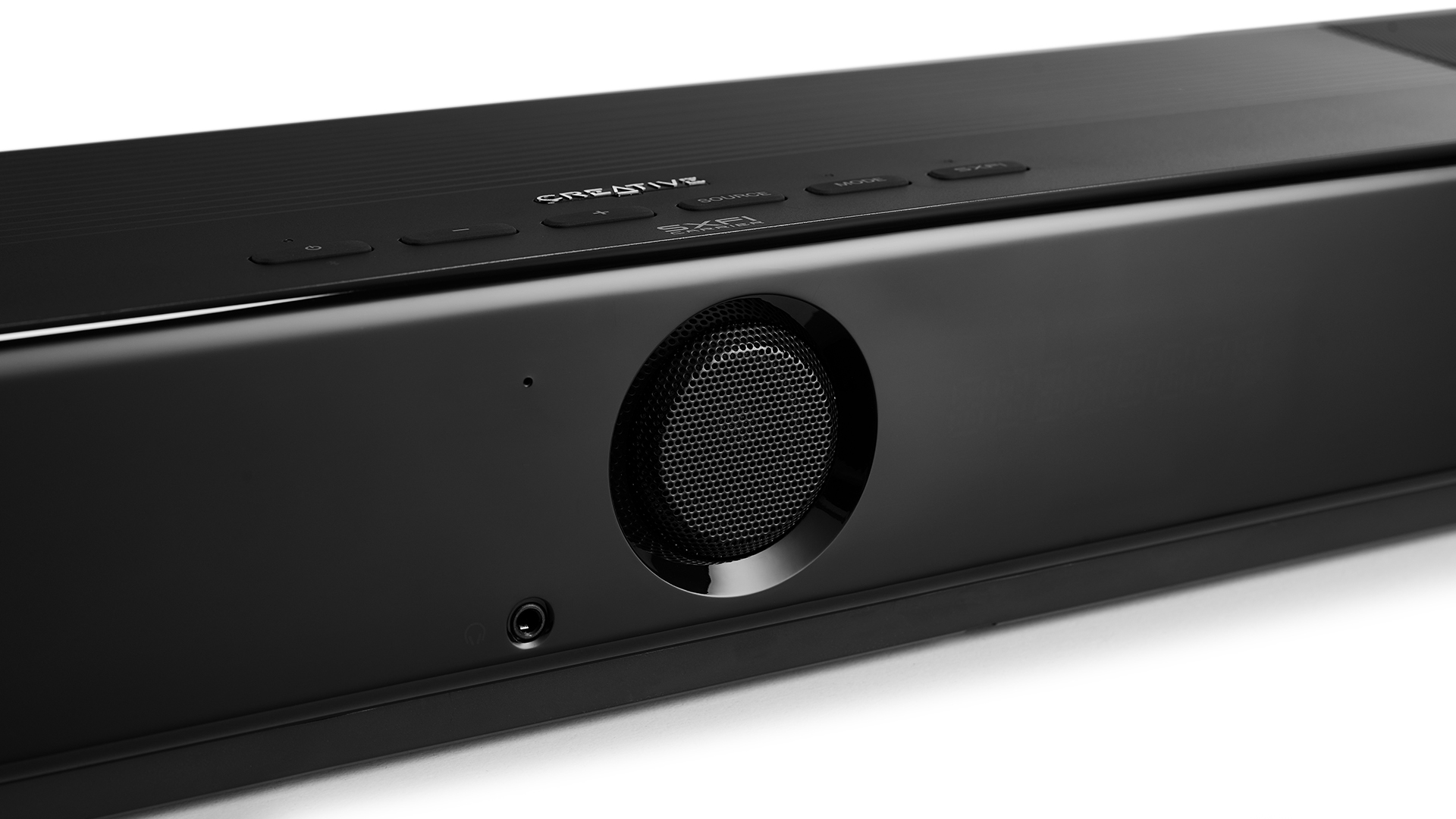
While it's not as sophisticated-sounding (or looking) as the equivalently priced Sonos Arc, the Creative SXFI Carrier is an entertaining and engaging speaker that's adept at movies and music but, unsurprisingly given its manufacturer, performs at its best with games thanks to a robust low-end and dynamic height effects.
The SXFI spatial processing with which it shares its name is a bit of a novelty, being neither particularly useful nor successful, which is a shame as without it perhaps the Creative SXFI Carrier could be more competitively priced. However, this soundbar has more to offer besides headphones symbiosis, and those looking for a multifunctional, desktop-sized speaker system should certainly consider it.
SCORES
- Build 4
- Sound 4
- Features 4
MORE:
Read our review of the Sonos Arc
Also consider the Samsung HW-Q950A
Read our Sennheiser Ambeo review
These are the best soundbars 2022: the best TV speakers you can buy
What Hi-Fi?, founded in 1976, is the world's leading independent guide to buying and owning hi-fi and home entertainment products. Our comprehensive tests help you buy the very best for your money, with our advice sections giving you step-by-step information on how to get even more from your music and movies. Everything is tested by our dedicated team of in-house reviewers in our custom-built test rooms in London, Reading and Bath. Our coveted five-star rating and Awards are recognised all over the world as the ultimate seal of approval, so you can buy with absolute confidence.
-
SXFIGAMERPC I am one of the LUCKY to have it. I have always been a fan of Creative sound and hardware since the days of the first SoundBlaster Live 5.1 sound cards. Creative has always made it impressive with sound in games with their famous EAX(2.0,3.0,4.0,5.0). Just compare the sound of some games with EAX and without EAX these days and you'll find that it gets worse without EAX. We have an example in DOOM 3, which when it originally came out supported EAX 4.0 and years later they made a revision without EAX support and there is no color in the sound: much worse. We have more examples in TRINE, which initially had EAX 5.0 support in its first version and when they updated it to TRINE ENANTHED (with better graphics) they removed the EAX sound and therefore again sounding worse than the original Trine as it happened with DOOM 3.Reply
Actualmente tengo una tarjeta de sonido AE-9 y la tenia conectada a mis parlantes KLIPSCH R15-PM + subwoofer Klipsch R-110W 200W formando un conjunto 2.1
Pero el Klipsch ocupaba mucho espacio y cuando vi el SXFI CARRIER pensé que era hora de disfrutar mejor del espacio de mi escritorio y aprovechar el sonido Dolby Atmos (DASS en colaboración con Dolby). Cuando ordené el Carrier y lo puse en marcha, me sorprendió el sonido debido al tamaño (88 cm de largo), pensé que no sonaría tan bien e impresionante. Pongo demos con Dolby Atmos y lo que realmente me impresiona más es el sonido del Subwoofer que baja a 25Hz y te hace sentir como si estuvieras en el mismo cine con los sonidos graves que pueden aparecer en películas o juegos. Hasta el dia de hoy sigo IMPACTADO por este subwoofer que tiene 200W y puedo decir que para mi es el mejor Subwoofer que he escuchado. He escuchado otros subwoofers de otras barras de sonido Premium como las de Samsung o LG y no hay color (sin que el sonido que ofrecen los sub de estas marcas sea malo) sobre todo a la hora de envolverte con los graves. Algo impresionante pero cierto. No hay palabras. Impresionante y efectivo trabajo en Creative.
Luego en los juegos es pasar a otra dimensión del sonido. Escuchas COD Vanguard o cualquiera de los últimos COD's compatibles con Dolby Atmos u otros como Gears 5 (Dolby Atmos) y sientes que vas al cielo con el sonido. También tengo la sensación de que este Dolby Atmos que ofrece la barra es el mejor Dolby Atmos "virtual" que he escuchado de una barra de sonido de cualquier marca. Se nota el trabajo con Dolby.
Luego también es importante la compatibilidad con el SXFI TEATHER, que para mí ofrece el sonido más parecido al del cine gracias a su sonido holográfico 3D SXFI. Simplemente a otro nivel. Los bajos logrados me dan la sensación de estar escuchando en una sala de cine. Nunca me había sentido así antes.
El impresionante trabajo de Creative con el sistema SXFI también se debe en parte a que da la sensación de que estás escuchando el sonido fuera de tu cabeza pero dentro de tus oídos. Consiguen exactamente lo que se propusieron hacer.
Por lo tanto, no entiendo muy bien las críticas no tan positivas que hace Whathife al sistema SXFI, porque para mí va al siguiente nivel. Me pilla escuchando sonido con el TEATRO de noche para no molestar a mis vecinos y sobre todo para sentir que lo escuchas como si fuera un Home cinema 5.1.2.
Lo único que no me gusta es que conecto la barra a un monitor que no tiene entrada HDMI eARC y por lo tanto al sacar el sonido Dolby Atmos por HDMI de la gráfica a la barra Windows lo detecta como otra pantalla encendida el panel. control y que no puedo clonar con la pantalla principal porque tiene baja resolución. Y no puedo apagarlo sin que el sonido también se apague.
Entonces al final lo que hago es dejar el sonido por USB, donde no aparece la otra pantalla porque lo desactivo y cuando quiero escuchar sonido DOLBY ATMOS entonces lo activo.
Mi puntuación para el SXFI CARRIER es de 9,5 y más porque regalan el SXFI TEATHER (en España) y por tanto es como si valiera 199€ menos.
Bravo por Creative que debería recuperar y actualizar la barra SXFI SONIC CARRIER que es como la madre del SXFI CARRIER aunque fuera más cara.
